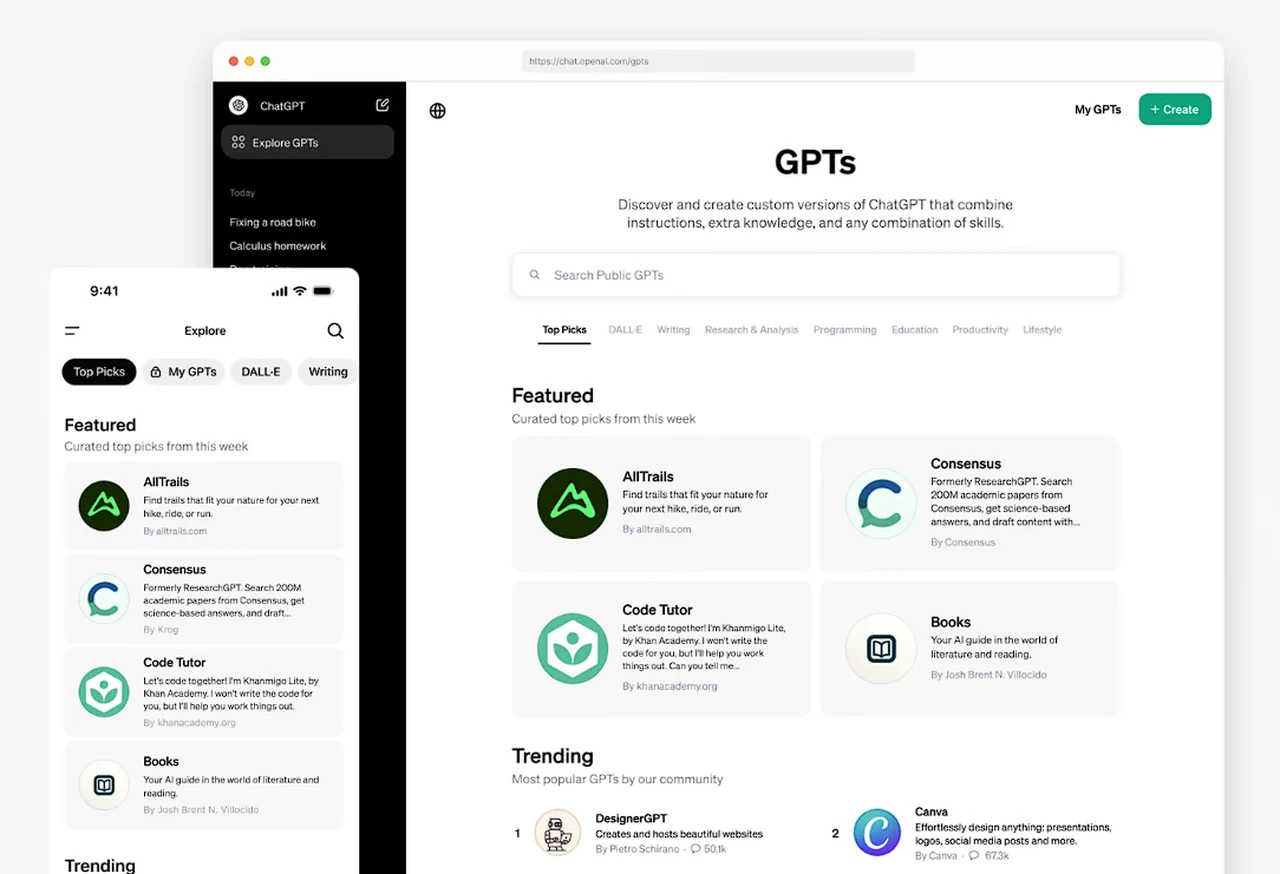
Even though OpenAI has not released its revenue model as yet for custom GPTs available in its GPT store launched at the beginning of this year. You can still use the GPT store to help improve your sales on already existing services, platforms and newly created AI models and services. This beginners guide provides more insight into how you can build ChatGPT custom GPTs and promote them on the GPT store ready for the new revenue service to be introduced possibly this month.
The world of technology is always on the move, and for those who keep up, there are plenty of opportunities to make money. One of the latest trends is the use of Generative Pre-trained Transformers, or GPTs. These are advanced tools that can create content, answer questions, and even write code. As we move through 2024, there’s a place called the GPT Store that’s getting a lot of attention. It’s a spot where developers and business-minded folks can sell their GPT creations. If you’re looking to get in on this, you’ll want to know how to make the most of it.
Imagine you’ve got a knack for building applications. With GPTs, you can create programs that do specific jobs, like writing marketing copy or optimizing websites for search engines. The trick is to make something that solves a real problem for people. Once you’ve built your GPT, you need to make it stand out. Think of a catchy name and a logo that pops. But don’t stop there. You’ve got to get the word out. Use social media, work with influencers, do whatever it takes to get people to notice your product.
Making money from ChatGPT custom GPTs
Now, if you’re really good at making these GPTs, there’s another way to cash in. You can offer your skills to companies. A lot of businesses are still waking up to what GPTs can do for them. You can be the one to help them understand and use this technology. You might even set up a system where you’re on call to help them regularly. To find clients, make sure you’ve got a strong online profile and a smooth process for managing projects.
Here are some other articles you may find of interest on the subject of creating custom GPTs :
The GPT Store isn’t just a place to sell your GPTs. It’s also a marketing tool. You can offer a free GPT that shows off what you can do. This can lead people to check out your other products or services. It’s a smart way to get new customers. But having a great idea for a GPT isn’t enough. You’ve got to build it well. There are tools out there, like GPT Builder, that can help you customize your GPT and make sure it’s top-notch.
Remember, your GPT has to impress the people you want to use it. So, making money with GPTs in 2024 is about being creative, knowing your tech, and being smart with how you sell your product. You’ve got to focus on what users need and keep up with the latest trends. If you can do that, you’ll find there’s a lot of potential to earn in the AI world
Promoting and making custom GPTs
Creating and selling custom Generative Pre-trained Transformers (GPTs) through platforms like OpenAI’s GPT Store represents a cutting-edge entrepreneurial venture. To navigate this process successfully, one must combine technical skill with strategic marketing. Here’s a quick guide on how to build, sell, and promote ChatGPT custom GPTs AI models.
1. Understanding GPT and Market Needs
- Grasp the Basics of GPT: GPT (Generative Pre-trained Transformer) is a type of artificial intelligence that generates human-like text based on the input it receives. It’s used for a variety of applications, including content creation, conversation bots, code generation, and more.
- Identify Market Needs: Research and identify specific problems or needs within your target market that a GPT application could solve. Consider industries that could benefit from automation, such as marketing for content creation or IT for code debugging.
2. Building Your Custom GPT
Let’s dive deeper into the strategies that can help you unlock the potential of GPTs for revenue generation. First and foremost, it’s essential to understand the audience you’re targeting. Whether it’s businesses looking to streamline their operations or individuals seeking to enhance their productivity, your GPT application must cater to their specific needs. This requires a deep dive into market research and user behavior analysis. By understanding the pain points of your potential users, you can tailor your GPT solutions to offer them the most value.
- Define the Application: Clearly define what your GPT application will do. This could range from generating marketing copy to providing coding assistance or even creating educational content.
- Use the Right Tools: Leverage existing tools and platforms such as OpenAI’s APIs, GPT-3 or GPT-4, to build your application. These platforms provide the necessary infrastructure and documentation to develop your GPT app.
- Customize and Test: Customize your GPT to cater to the specific needs you’ve identified. This involves training or fine-tuning it with relevant data. Rigorously test your application to ensure it meets quality standards and accurately serves its intended purpose.

3. Preparing for Launch
When it comes to marketing your GPT, storytelling can be a powerful tool. Share the journey of your GPT’s development, the challenges it can overcome, and the benefits it brings to users. This narrative can resonate with your audience, making your GPT more than just a tool—it becomes a solution that users can connect with emotionally.
- Create a Brand: Develop a strong brand for your GPT application. This includes choosing a memorable name, designing a logo, and establishing a visual identity that resonates with your target audience.
- Set Up Your GPT Store Presence: Create a compelling product page on the GPT Store. This should include a detailed description of your GPT’s features, benefits, and potential uses, along with any testimonials or case studies that can attest to its value.
- Pricing Strategy: Determine your pricing strategy. You could offer a one-time purchase, subscription model, or even a freemium version that provides basic functionality for free with the option to upgrade for more features.
4. Marketing and Promotion
Networking is also crucial in the GPT marketplace. Attend industry events, participate in online forums, and engage with other developers and potential clients. Building relationships can lead to collaborations, partnerships, and opportunities to showcase your GPT to a wider audience. Furthermore, consider the pricing strategy for your GPT. It’s a delicate balance between making your product accessible and valuing your work appropriately. Competitive pricing can attract more users, but don’t undervalue your GPT. Offering tiered pricing models or subscription services can provide users with flexible options while ensuring a steady revenue stream for you.
- Leverage Social Media: Use social media platforms to create buzz around your GPT application. Share valuable content that highlights the benefits of your app and engage with your audience to build interest.
- Content Marketing: Produce and distribute content such as blog posts, videos, and infographics that showcase your GPT’s capabilities and real-world applications. This can help educate your potential customers and drive traffic to your GPT Store page.
- Network and Collaborate: Attend industry events, webinars, and forums related to AI and your target market. Networking can lead to valuable partnerships, collaborations, and opportunities to showcase your application to a wider audience.
- Offer Demonstrations: Provide live demos or free trials of your GPT application. This allows potential customers to experience its value firsthand, increasing the likelihood of purchase.
- Collect and Act on Feedback: Gather feedback from early users and continuously improve your product. This not only enhances the application but also shows your commitment to customer satisfaction.
Customer support and feedback loops are vital components of a successful GPT product. Users may encounter issues or have suggestions for improvements. By providing responsive support and incorporating user feedback into your development process, you can enhance your GPT’s functionality and user experience, leading to higher satisfaction and retention rates.
5. Legal and Ethical Considerations
Lastly, keep an eye on the legal and ethical considerations surrounding GPTs. As AI technology advances, regulations and guidelines are evolving. Ensure that your GPT complies with data privacy laws and ethical standards. Being proactive in these areas can prevent potential legal issues and build trust with your users.
- Privacy and Data Security: Ensure your GPT application complies with data protection laws like GDPR or CCPA. Be transparent about how you collect, use, and store data.
- Ethical Use: Adhere to ethical guidelines for AI development and use. This includes avoiding biases in your GPT’s responses and ensuring it does not generate harmful or misleading content.
- Intellectual Property: Respect intellectual property rights and ensure your use of data and AI technologies does not infringe on others’ copyrights or trademarks.
In essence, the journey to monetizing GPTs is multifaceted. It involves a blend of innovation, technical skill, marketing acumen, and a deep understanding of your audience. By focusing on these areas and staying adaptable to the ever-changing digital landscape, you can position yourself to reap the financial rewards that GPTs offer. Whether you’re a seasoned developer or an entrepreneur stepping into the world of AI, the GPT Store presents a unique platform to showcase your talents and grow your income.
Filed Under: Gadgets News, Guides, Top News
Latest timeswonderful Deals
Disclosure: Some of our articles include affiliate links. If you buy something through one of these links, timeswonderful may earn an affiliate commission. Learn about our Disclosure Policy.

